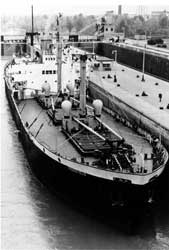Here ye go... sorry mao, no politics with this wreck
 Shipwreck: Ridgefield
By Skip Gillham, Vineland, Ontario, Canada
Shipwreck: Ridgefield
By Skip Gillham, Vineland, Ontario, Canada
[FONT=arial, helvetica][SIZE=-1]

[/SIZE][/FONT]
The
Ridgefield was one of approximately 2,700 Liberty ships that were built in the United States during World War Two. These vessels were a standard design and construction and provided outstanding service all over the world. They delivered war supplies to the troops and then helped rebuild countries devastated by years of fighting.
The Liberty ships shared dimensions of 441 feet, 6 inches, in length and had the ability to carry 10,000 tons of cargo. They were steam powered and each had a 2,500 horsepower triple expansion engine.
What became the
Ridgefield was built by the New England Shipbuilding Corporation of Portland, Maine. It was completed in February 1945, as
James A. Butts and was initially managed for the United States Maritime Commission by the Calmar Steamship Corp. Beginning in 1946 States Marine Corp. took over management and, a year later, they purchased the ship.
The name was changed to
Lonestar State in 1947, Lone Star State in 1951,
Anniston in 1955 for the Ace Steamship Corporation and
Caldwell for Caldwell Transportation in 1957.
After twelve years under American registry, the vessel was sold to the
Ridgefield Navigation Company Limited later in 1957 and registered in Liberia as
Ridgefield. The ship worked as a tramp steamer and saw service on a variety of saltwater routes.
Prior to 1959 freighters larger than 261 feet in overall length could not enter the Great Lakes via the St. Lawrence due to the small locks between Montreal and Lake Ontario. This was changed with the construction of the St. Lawrence Seaway and over 200 different Liberty ships, including the
Ridgefield, came inland to ports such as Duluth, Thunder Bay, Chicago, Detroit, Cleveland and Toronto exchanging cargoes to and from world ports.
Ridgefield had three trips to the Great Lakes in 1961 and another in 1962 before being lost later in the year. The vessel is shown upbound in Lock 4 of the Welland Canal in a photo from the collection of Shipsearch Marine.
Late on December 18, 1962,
Ridgefield was traveling in ballast from Maracaibo, Venezuela, for a U.S. Gulf Coast port when it stranded off the east end of Grand Cayman Island. The ship was lodged securely on the rocks and salvage efforts were fruitless. Before long the hull broke in two.
The crew abandoned the
Ridgefield and the ship was left to the relentless action of the sea. Waves pounded the hull and it was slowly broken apart. Sections of the old Liberty were still visible in 1981 and likely many years later.
---
Rick
 [/SIZE][/FONT]
[/SIZE][/FONT]